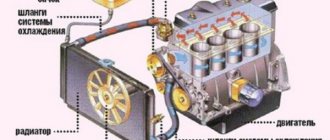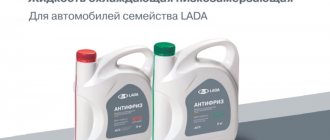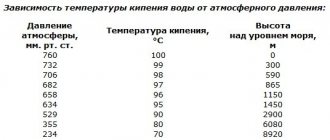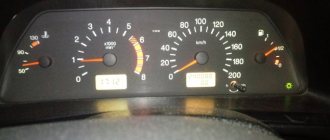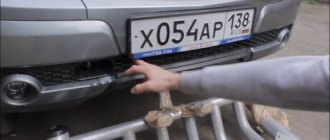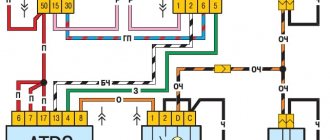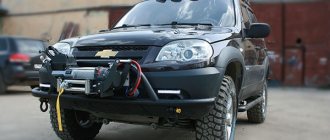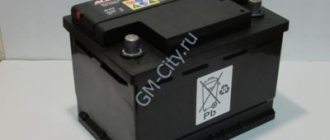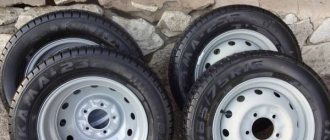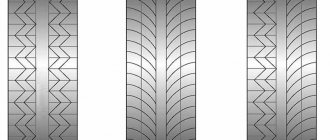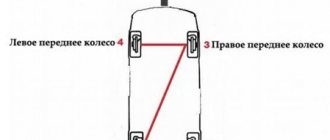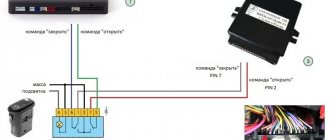Filled new antifreeze into Niva Chevrolet
After the next few short rides, my Shevik began to behave strangely - when starting up, it almost immediately began to warm up.
If before the car warmed up to 60-70 degrees in exactly 5 minutes, now it takes about one and a half to two minutes. There’s nothing to do, I heated it up to 90 and climbed under the hood to see if the fans were working. As you know, the Chevrolet Niva has two of them and they turn on in different ways and for models of different years - for some, both at the same time, and for others, first the right one, then the left one. To avoid confusion, count the fans while sitting in the driver's seat - the right one means the one on the passenger side. Left - driver's side.
I read the forums - first the right one should turn on at approximately 93, and the left one should turn on as an additional one at 102 degrees, that is, to quickly extinguish the “fire.” (By the way, the operating mode and temperature depend on the firmware version of the brains). Then they both thresh, cooling to 93. For me, only the right one turned on, and the left one remained there, even when the temperature exceeded the red zone. Well, I think Carlson has blown up or the fuses or relays have blown.
Useful to look at the fuses and relays. For cooling system fans, they are located under the glove compartment, exactly above the passenger's feet. I went to work first with a screwdriver, because the main fuse box on the driver's side is unscrewed with a Phillips screwdriver. And it broke off - for the “passenger” block you will need an 8 mm key.
You unscrew it - there will be relays in the middle, and on the right and left there are big red ones - 50 ampere fuses. And 3 more small blue ones of 15 amps each. I checked everything that was there - everything is in order.
I also tampered with new ones - the fan won't spin. This means the relays and fuses are ok.
Then I remembered that the pump on my six was breaking and I also had the same problem - the car warmed up quickly. The pump was closed - there was no antifreeze in the system, which means there was nothing to “drive” there. I think there might be a problem here too - I looked into the expansion tank - what an idiot I am, there is no antifreeze. At all. So the whole point is simply this: the coolant has run out.
However, where did the coolant go then? If it leaks, it means either the pump has closed again, or the radiator or pipes are leaking. Everything needs to be checked, look for where the leak is and fix it. It often happens that leaks occur in places where hoses are secured with clamps.
I ask myself this question and immediately remember how the seller told me that he filled it with antifreeze. Otherwise, I’m used to pouring the cheapest antifreeze into the six.
The difference between antifreeze and antifreeze is that it’s all about the additives. But in any case, antifreeze will be healthier for the car. I read a bunch of forums where most people advise pouring antifreeze into the Chevrolet Niva. Since you don’t really want to save money on your car, you want to fill it with optimal fluids, and then the car will last longer.
In general, they advised me to fill in G11 or G12 antifreeze - the most normal and relatively inexpensive. I looked in the store - there are 5 liters of green for 487 rubles and 5 liters of red for 417. As the seller explained, red is for aluminum blocks, and green is for cast iron. Although it seems like red is considered “cooler” and should cost more))
In general, I bought this one for 417 rubles; when I poured it, the color was orange.
I found a more understandable explanation on the Internet - green creates a protective film over all the internal surfaces of the cooling system. This plaque reduces the internal diameter of tubes, pipes and other elements of the system. As you understand, this is not a buzz; the cooling efficiency deteriorates. But red antifreeze, more expensive, covers only the places where corrosion has formed with a film. And it lasts longer, this is already a proven fact. So if you are pouring antifreeze into an already tested system (it doesn’t ooze anywhere, it doesn’t “snot”, the pump doesn’t leak, the pipes are stretched, etc.), then feel free to take the red one, it’s a hundred more expensive, but more efficient and better.
In general, I took the green one for now, it was cheaper, in case it turns out that the pump is covered and it all leaks out. Although then, should I just take the cheapest antifreeze at 180 rubles for 5 liters and fill it up for now? If it leaks, don't mind it. But a pump malfunction will not be so expensive to diagnose)) Of course, if the hoses and pipes are checked and the clamps are tightened. Damn, I don't like it when the car breaks down. Well, to hell with it, I filled it with red, let's see how things will turn out.
For those who like to pour water instead of antifreeze in the summer, I’ll explain - antifreeze and antifreeze also take much longer to boil than water. I remember once we were making our way through the forest in a six-wheeler, there was little antifreeze, the engine got hot and the pipe leaked. I had to pour water into the radiator in the field, but then I got tired of adding water every couple of kilometers. The water boiled away instantly. It was a complete bummer.
I drove for a whole year without any breakdowns, of course the car is from 2004, although it has been rebuilt, it will still be naughty in small ways. The main thing is to have time to eliminate minor troubles in time so that they do not transform into major ones)) Good luck to everyone and do not have problems with the car.
FakeHeader
Comments 48
Antifreeze is the same as antifreeze... well, so that they know)
Phoenix red antifreeze
Antifreeze Aga Red
Antifreeze and antifreeze are ethylene glycol with water, plus dye and additives that no one can detect by eye.
Good afternoon. I use green antifreeze, but... If the problem is with an unpredictable increase in pressure, then it is not difficult to solve it - There is a valve with a spring in the cover of the expansion barrel. It's on the latches. We pull it out of there, bite off half of the spring and put it back together. I found only one downside here - from time to time you need to add coolant - it boils over. But this may not even be a minus - the liquid is renewed.
Read more: Vibration when turning the steering wheel
If you drive through normal mud, half of the antifreeze will boil away in 5 minutes. I tried adding antifreeze and antifreeze, with the cap unscrewed, most liquids boil at a temperature of 90-95 degrees according to a working sensor, which is next to the thermostat and a regular thermometer stuck in the expansion tank. At the same time, there is still no command to turn on the fans, and everything boils over, you can check it yourself. Most antifreezes and antifreezes are bad or fake; you need to buy them only in trusted places and are expensive. . Everyone liked the antifreeze polar explorer the most.
Dzerzhinsky antifreeze was filled from the factory - this is GM-AvtoVAZ's answer. I use antifreeze - G12 or G12+. The level in the tank almost does not rise when antifreeze is heated, unlike antifreeze, and it is not so smelly.
Antifreeze for “every day”. Green. There is no other one)
Which is better oil or oil... KMK today one of the best antifreezes is SINTEC EURO green ;-)) or something cheaper from this manufacturer’s line...
G12+ Red Lukoil.
Antifreeze "Felix". No comments. Anyway, the Shniv cooling system periodically requires attention, so the antifreeze is always fresh)))
Green antifreeze from Lukoil, I take it exclusively at branded gas stations, no problems)
I use antifreeze Felix, for 110 thousand no problems with the cooling system
and I changed the Felix antifreeze, I thought it was of poor quality when I saw the brown foam. But the problem, alas, remains (((Only now there is no foam but an oil film apparently...
cylinder head breakdown. oil gets into the antifreeze. Over time, the oil pipes will become very swollen
Before the gasket blew and oil got into the coolant there was antifreeze. I flushed the system 4 times with a jet and once with cheap antifreeze. Now I'm pouring Felix antifreeze. I don't feel much difference. If only it doesn’t stink as much when overheated as the former antifreeze. The tolosol has turned brownish, I think I’ll fork out the cash and change the barrels and pipes, but that’s a completely different story
So, after the capitalization, I had a brown layer on top in the tank (I described the problem in the magazine earlier). I thought the antifreeze was not of good quality, I changed the antifreeze, the problem reappeared after a while. Although almost 6 months have passed and no problems with the engine have been noticed (pah-pah). The mechanic said maybe it was leaking from the radiator. And I myself am guilty of a poor-quality gasket, because oil is slowly leaking around the perimeter of the cylinder head. Over 10,000 km I probably added a little more than 1 liter of oil. So I’m thinking of leaving it and driving another ten kilometers. or change(((
I decided for myself that as long as it doesn’t break, I won’t change it. Because everything is fine anyway. The car is 6 years old, I’ll climb something else and break it along the way
I drink everything that is more expensive than 1000 rubles per 10 liters, and this is Felix, Syntek, Nord. From g12+ red, switched to green.
I always poured Felix antifreeze and changed it after 60 thousand km, as required by the service book. Now the mileage is 190 thousand. There were no problems with the pipes, with the exception of antifreeze leakage under the volute (I installed another clamp) and from the lower radiator pipe (you can’t get there without removing the radiator). I changed the tank a couple of times, then adjusted the lid
Read more: Do-it-yourself cleaning of diesel injectors
I filled up Sintek with 12++, and before that I did this www.drive2.ru/l/469003282971361942/
If you do nothing with the cooling system, then with antifreeze it will flow the same way, only more expensive) You need to change the tank to a high-quality one with a normal valve that does not rot, adjust the valve, fill in antifreeze
You just need to seriously inspect the cooling system once and forget for a long time, and changing the pipes one at a time is a waste of time, always in trouble and repairs. I always pour Castrol concentrate for myself, well, of course I dilute it with water according to the scheme. For example, when I need to replace a radiator , I do this and forget for a very long time www.drive2.ru/l/464034589925442160/
Do you know why tanks burst? The boiling point of Dzerzhinsky antifreeze is 84 degrees Celsius, the boiling point of Siberia antifreeze is 86 degrees Celsius, the boiling point of water is 91 degrees Celsius. (all measurements were carried out in the mountains at an altitude of 1700 meters because I live high, on the plain it will be 8-9 degrees higher, respectively) This means that at the same temperature, the pressure in the system will be different. With antifreeze, the likelihood of leaks increases. I myself drive on antifreeze, I have to force one fan to start manually so as not to bring the antifreeze to the boiling point, so there were no leaks and no leaks, not to mention the tank.
Lil Felix, on a trip to Russia, switched to some kind of Dzerzhinsky, they said it was just bullshit from one barrel. The return filter is a classic one, I change it regularly, the fluid is clean.
Antifreeze - it’s a hell of a lottery here. Basically a leftist of some kind, he eats aluminum for his sweet soul. The neighbor saved a lot of money - first the pump, then the thermostat, and just now the plug-plug just fell out of the block. Lada 2107 is one of the latest, well-groomed and not capricious. But after salting, a black streak began to appear. He switched to antifreeze after a pipe burst and all the antifreeze was drained into the atmosphere.
The Lada engine is not glamorous so that it can amuse itself with multi-colored liquids and will work on antifreeze and water
Right now antifreeze costs the same as normal antifreeze. Lew Felix or Syntek (what can be quickly found in local stores if necessary). No problems. Z.Y. Cheap (fake) antifreezes for 400 rubles boil at 80 degrees.
Water from the swamp is ok.
Water from the swamp is ok.
Water removes heat much better than antifreeze. I wish I didn't freeze in winter...
Well, so that it doesn’t freeze, I pour water from the Gulf of Finland, it’s salty. And so the water cannot freeze because... The engine is heating it up!
Stages of replacing Chevrolet Niva coolant
When switching from antifreeze to antifreeze, it is necessary to flush the cooling system. This is done so that the new liquid does not lose its properties when mixed. Also, due to the different chemical composition, a precipitate or flakes may form. Therefore, the correct procedure between draining and filling should include a flushing step.
This model is quite popular, so many people know it under other names:
- Chevrolet Niva;
- Chevy Niva;
- Shniva;
- VAZ-21236.
We will consider the instructions for replacing the coolant using the example of a 1.7-liter gasoline engine. But there is one nuance: cars after the 2021 restyling have electronic control of the gas pedal.
Accordingly, there are no pipes for heating the throttle valve. Therefore, we will consider bleeding air on this modification. You can also familiarize yourself with the nuances of replacement on a regular Niva 4x4, the replacement on which we also described.
Coolant drain
To drain the antifreeze, you need to place the car on a flat surface, open the cap of the expansion tank and wait a little until the temperature drops below 60°C. For further convenience, remove the decorative plastic protection on top of the engine.
Further in the instructions we are recommended to turn the temperature regulator to maximum. But it is useless to do this. Since the temperature control in the Chevrolet Niva occurs by moving the air damper. And not by blocking the radiator as in old VAZs.
After the machine has cooled down a little, we begin the draining process itself:
- If you stand in front of the car, at the bottom right, there is a plastic valve on the radiator that closes the drain hole. We unscrew it to drain the antifreeze from the radiator (Fig. 1). When unscrewing, be careful not to lose the rubber O-ring.
In this way, we completely drained the old fluid, but in any case, a small part still remains in the system, distributed among the engine channels. Therefore, in order for the replacement to be high-quality, we proceed to flushing the system.
Flushing the cooling system
If the Chevrolet Niva cooling system is not clogged, but is simply undergoing a scheduled replacement, then we use ordinary distilled water for flushing. To do this, close the drain holes and pour distilled water into the expansion tank.
Then close the tank cap and start the engine. We warm it up until the thermostat opens to flush both circuits. Next, turn it off, wait for it to cool and drain the water. To achieve a good result, it is recommended to do this procedure 2-3 times.
If the car system is heavily contaminated, it is recommended to wash it with special chemical solutions. For these purposes, washes from well-known brands, such as LAVR or Hi Gear, are suitable. Recommendations, as well as instructions, are usually printed on the back of the container with the composition.
Filling without air pockets
To properly fill new antifreeze into a Chevrolet Niva, you need to perform a number of steps. After all, it depends on whether an air lock forms in the system or not. We will close the drain holes in stages, so for now we will leave them open:
- We begin to pour antifreeze into the expansion tank, as soon as it flows through the drain hole in the radiator, we put the wing plug in place.
- We continue the flood until it starts flowing from the hole in the block. After which we close it too. The drain bolt on the block must be clamped with a slight force, approximately 25-30 N•m, if you have a torque wrench.
- Now we need to bleed the air from the top of the radiator. To do this, we find a special plug, the location of which is shown in the photo (Fig. 3). We unscrew it a little, continue to pour antifreeze into the tank, as soon as it flows, screw the cap back into place.
The system is completely filled with new antifreeze, now all that remains is to start the engine, wait until it warms up completely, and check the level. Some people advise starting the car with the reservoir open and closing it after 5 minutes to get rid of air pockets as much as possible. But when replacing according to these instructions, they should not be there.
Video
Chevrolet Niva is the most affordable all-wheel drive SUV on the Russian market. Despite the outdated design, the car is still as relevant as ever. This is facilitated not only by the utilitarian classic design, but by the legendary maintainability. The simple design allows you to service the car in a garage using available tools
It will not be difficult to change the oil in the gearbox, however, special attention in this article is paid to the volume of oil in the transmission
However, it is equally important to know other parameters, including the frequency of oil changes, how to choose the right one and which best brands to choose.
In the case of the Chevrolet Niva, the plant recommends replacing the transmission substance every 45 thousand kilometers. It is noteworthy that in this case the manufacturer took into account difficult operating conditions. However, this car is precisely intended for heavy road testing. The SUV tolerates overloads well, and the powerful and durable suspension provides excellent ride comfort and outstanding cross-country ability. We are talking about something else - the service life of the oil, which in such operating conditions will have to be changed much more often than required according to the regulations. Therefore, the 45 thousand kilometers limit can be called conditional. In addition, the endurance of the oil is also negatively affected by the human factor, namely the driver’s mistakes, which he makes in harsh conditions - for example, he incorrectly shifts from one gear to another (or does not operate the clutch correctly), constantly exceeds the speed, makes sudden maneuvers, etc. etc. At the same time, you can add here dirt and slush on the roads, high humidity, and various precipitation (for example, rain with snow and hail). Based on this, we can conclude: even if the car is adapted to heavy loads, this does not mean that the oil in such conditions is also designed for a long service life. Over time, it will lose its properties, but in this situation it will happen much earlier. Therefore, more frequent oil changes cannot be avoided. For example, experienced Niva owners prefer to reduce the regulations to 30 or 25 thousand. In addition, they check the oil volume in advance and constantly monitor its condition.
Replacement frequency, what antifreeze to fill
In the maintenance information for Niva Chevrolet, it is recommended to change antifreeze every 60,000 kilometers. But many car enthusiasts are not happy with the flooded antifreeze, which becomes unusable by 20 thousand. Dzerzhinsky antifreeze is usually filled from the factory, but there is also information about pouring red antifreeze.
When choosing coolant, it is better to use a concentrate rather than a finished product. Since it can be diluted in the required proportion, because after flushing there is still some distilled water left in the system.
A good choice would be Castrol Radicool SF concentrate; it is what dealers often recommend for use. If you choose ready-made antifreezes, then you should pay attention to the red AGA Z40. FELIX Carbox G12+ or Lukoil G12 Red with good reviews.
How much antifreeze is in the cooling system, volume table
| Model | Engine capacity | How many liters of antifreeze are in the system | Original liquid / analogues |
| Chevrolet Niva | gasoline 1.7 | 8.2 | Castrol Radicool SF |
| AGA Z40 | |||
| FELIX Carbox G12+ | |||
| Lukoil G12 Red |
How much to fill
The information below was provided by the official LADA website.
Engine oil to the engine
:
- from May 2021 synthetics ROSNEFT MAGNUM MAXTEC 5W-40 according to STO 44918199-091-2017
Transmission oil in the gearbox (gearbox)
:
- for manual transmission and transfer gearbox: Rosneft Kinetic Hypoid 80W-90 STO 44918199-083-2017 mineral.
Coolant (antifreeze)
:
Brake fluid
:
- It is unknown what kind of oil is in the power steering from the factory. At LADA dealerships, when replacing the steering mechanism, they use Pentosin Hydraulic Fluid CHF 11S (information from the LADA dealership from material consumption standards).
Attention!
This information is for reference only and may be changed by AVTOVAZ without prior notice to the Buyer. For information on recommended working and lubricating fluids, we recommend contacting an official LADA dealer.
Still have questions? Ask in the comments!
Other reference information on Lada Niva is provided here.
Leaks and problems
When replacing the coolant, you should inspect all pipes and connections for possible problems. After all, when the fluid is drained, it is easier to replace them than to tear them during operation. You need to pay special attention to the clamps; for some reason, many people use ordinary worm clamps. Over time, they squeeze the hoses, causing them to break.
In general, the Chevrolet Niva has several main problems related to the cooling system. It often happens that antifreeze leaves the expansion tank. The plastic on it constantly bursts, which causes leaks. In this case, replacement will be required.
Another problem is antifreeze under the driver's mat, which can cause a sweetish smell in the cabin and also fog up the windows. Most likely the culprit will be a leaking heater radiator. This problem is usually referred to as “a chef’s nightmare.”
There is also a situation where antifreeze is thrown out of the expansion tank. This may indicate a broken cylinder head gasket. This is checked as follows. With the car completely cooled down, remove the expansion tank cap, after which you need to start the engine and rev it up intensively. It is advisable to have a second person so that he can see whether the antifreeze in the tank will bubble at this time.
What to do if liquid leaks? What kind of breakdowns happen?
Even when the vehicle is running normally, the coolant level may drop, indicating a fluid leak. Leaks can occur from the pipes due to poor fastening of the clamps and the radiator, as well as damage to the pipe cores. If the gasket burns out, antifreeze leaks out from under the block head.
An antifreeze leak may occur due to engine overheating. When the coolant level is low, it boils. The cause of engine overheating may also be a broken thermostat, replacing which the problem will disappear. Eliminate the possibility of loss of antifreeze by replacing faulty parts with new ones.
The most common causes of coolant leakage: damage to tubes, pipes, gaskets or hoses.
If the coolant leaks out, the problem is easy to find and eliminate the loss of antifreeze. Difficulties arise when antifreeze leaks into the power unit. In this case, a coolant leak will lead to repair of car engine parts.
To avoid consumable leakage:
- Regularly check the coolant level in the expansion tank and lubricant in the engine.
- Inspect the joints, hoses and fastenings of the entire cooling system.
- Use coolants recommended by the vehicle manufacturer.
By following all the recommendations, you can keep the system in working condition for a long time, extending the operation of the machine for many years.
Types of coolant
Antifreeze is a liquid that is a mixture of pure distilled water, propylene glycol and various additives. Water is used as a universal solution, and propylene glycol makes the liquid viscous and sticky. Additional additives provide better engine cooling and also perform a number of additional functions depending on the composition:
- silicate additives prevent metal oxidation and also reduce the overall temperature of the liquid;
- carboxylate additives destroy fatty deposits on the walls of the cooling system channels and also increase the shelf life of antifreeze;
antifreeze with special additives on sale , which can perform a number of specific functions - they prevent the liquid from freezing at subzero temperatures (relevant for cold regions), eliminate scale and foam (relevant for old problematic engines), and so on.
Recommendations for choosing for Chevy Niva
To determine which antifreeze is best to pour into your Chevrolet Niva, you need to know which one was filled from the factory, since each model has a lot of specific nuances. However, in most cases, the choice of coolant depends on the year of manufacture of the car:
- for older models that were produced before 2001-2002, class G12 fluid is suitable;
- for later models (from 2003 to 2010), G12+ antifreeze is suitable;
- for modern models (manufactured after 2010), it is recommended to purchase coolant category G12++.
Also, many people use the domestic mixture Antifreeze class TS-40 as antifreeze. Motorists often speak negatively about Antifreeze, but in its properties this liquid is practically no different from foreign antifreezes. To understand the absurdity of negative reviews, you need to remember that most Chevrolet Niva cars are filled with antifreeze at the factory.
The only major drawback of antifreeze is its shorter service life in comparison with G12 mixtures - in this the domestic cooler is really inferior to its foreign analogues. The recommended replacement frequency is 30 thousand km, and for some antifreezes the interval between replacements can be up to 200 thousand km.
To find out more information, watch the video in which an expert answers the question of what is better - antifreeze or antifreeze:
Classification (VAG concern)
The most popular classification is the Volkswagen-Audi tolerance system. Now they have changed the designations, but everyone basically writes these “mysterious symbols” on the cans.
G11 – ethylene glycol base, the cheapest coolant, with a small package of additives. Usually blue-green in color. Russian analogue of "Tosol". Action: covers ALL walls of the cooling system with a thin film, which should protect against corrosion. The disadvantage is that this film is a very good thermal insulator and quite significantly reduces the efficiency of the cooling system. Recommended service life is 2 years (data taken from the German directory). One year of operation in Germany is equivalent to 20 thousand km, but whether the car was parked or driven does not matter.
G12 – base ethylene glycol, additives – carboxylate compounds. Usually red. It acts locally on areas of corrosion and for this reason has significantly better heat removal. Long-playing. Service life without loss of characteristics is more than 5 years. G12+ - polypropylene glycol base. The color is usually orange. Made for the sake of the environment. Non-toxic, can decompose naturally in nature. The boiling point of this antifreeze is increased to 135 degrees.
Neste antifreeze, concentrate
Freezing and crystallization. What is it and what is the difference. According to our GOSTs there is no difference, but according to Western standards there is. Crystallization temperature is the state at which crystals begin to form in a liquid. Ice slush forms. The freezing point is the point at which antifreeze becomes a “solid state.” It does not harden like ice, but rather looks like cooled semolina or oatmeal (whoever liked which one more in kindergarten). For the antifreeze I presented in this article, the crystallization temperature is minus 35, the pour point is minus 42.
ready antifreeze Total
Replacement procedure
After choosing the type of coolant, we will consider how to change antifreeze in a Chevrolet Niva.
Required Tools
First you need to find an inspection ditch or lift to access the car from below.
Now you need to prepare the following tools:
- wrench 10;
- pliers;
- flat screwdriver;
- funnel for filling a new cooler;
- container for draining old fluid (volume of at least 8 liters);
- distilled water (if required).
Next, let's look at how to drain antifreeze with your own hands:
- Turn off the engine and wait until the system cools down completely.
- Open the hood, find the expansion tank and remove the cap from it. The lid should be unscrewed gradually, as hot air may accumulate under it.
- Find the drain hole and place a container over it.
- Remove the drain plug and wait a while for the old fluid to drain out of the tank.
For a more visual representation of the process, we recommend watching the video:
Filling with new coolant
Now let's study the instructions on how to fill:
1. Carefully read the instructions for the cooler - the fact is that in some cases antifreeze is sold as a concentrate, so sometimes it needs to be diluted with distilled water according to the instructions (usually a ratio of 1 to 1 or 2 to 3 is used).
2. Insert a funnel into the hole and pour antifreeze into the system (pay attention that the liquid should not exceed the MAX mark).
3. While filling, periodically press the radiator tube - this will avoid the appearance of air locks in the system.
4. Close the tank and start the engine.
5. Turn on the interior heater fan and pay attention to the air temperature - if the air is very cold, then a plug has formed in the system. To eliminate this defect, remove the cap on the radiator and run the engine for 5-10 minutes, then turn off the engine and close the cap.
6. Get into the car and drive 10-20 kilometers, and then check the coolant level and, if necessary, add antifreeze to the maximum according to the standard algorithm (sometimes after refueling, some of the antifreeze evaporates for natural reasons).
Replacement frequency
The cooler on a Chevrolet Niva should be replaced according to factory standards. On average, you need to replace it every 40-60 thousand kilometers, depending on the model. In some cases, you need to fill the coolant more often, for example, if the engine life is approaching a major overhaul, or the antifreeze has turned brown or black.
Important: If you use your car very rarely, you should fill it with antifreeze at least once every 3-4 years.
Antifreeze for Chevrolet Niva
for Chevrolet Niva repair
I decided to bother flushing the cooling system. I purchased 35 liters of distilled water, 3 ton flushing and Sintec antifreeze. I washed it 6 times, 2 washes with chemicals. The color of the wash is yellowish, which is why the coolant had that tint. The end result was pleasing. I drove 3 thousand km with antifreeze, the color of the liquid looked like it had just been added.
Mine is filled with Felix antifreeze from the factory. I'll finish it until the fall and switch to Gulf Stream antifreeze in the winter. I tried it in a mug and it starts to boil at 106-108 degrees, but in a system with pressure it will be even better. My son’s field was converted to normal a long time ago.
Antifreeze Felix g-12 -40, replacement every 50,000 thousand and clean as a tear.
Three years have passed since replacing the standard coolant with SINTEC UNLIMITED G12++ antifreeze. During this time, the color has hardly changed, the expansion tank is clean. The service life of antifreeze is not limited. Guaranteed shelf life is 5 years.
Write your review about antifreeze
Help others - tell us about your experience using the spare part.
- loading.
- loading.
- loading.
- loading.
- Vectra
- Mokka
- Antara
- Astra
- SPORTS TOURER
- Meriva
- Zafira Tourer
Voted FOR TOTACHI engine oil on the rating page
The CARMEDIA radio has only 15 voices! Do you recommend?
Voted AGAINST Petro Canada motor oils on the ratings page
The Knecht air filter has only 10 votes! Do you recommend?
Voted FOR Effiplus tires on the rating page
KRAFTOOL tool sets have only 7 reviews. Perhaps you will add another one?
ZF power steering pumps have only 7 reviews. Perhaps you will add another one?
FULDA tires only have 3 reviews. Perhaps you will add another one?
Shell manual transmission oil only has 20 votes! Do you recommend?
There are already 25 reviews written on BERU.
The tires are expensive, of course, but they are worth it, and it’s not a pity for your swallow)). There is no noise, the road grip is excellent.
Personally, I really liked the AGC glass, I’ve been driving with it for two years now, I don’t know how many kilometers it was, I haven’t tracked it. Odie.
March 3, 2021, 11:48 pm
There are already 25 manufacturers participating in the auto rating of fuel pumps for Volkswagen Passat!
March 3, 2021, 11:20 pm
There are already 25 reviews written on Kedr.
March 3, 2021, 10:10 pm
Prosto Kitai, net cdes Italiji.
3 March 2021, 20:53
There are already 5 manufacturers participating in the auto rating of oil additives for Opel Astra!
VAZ (Lada) 2113/2114/2115
3 March 2021, 16:55
There are already 5 manufacturers participating in the auto rating of motor oils for VAZ (Lada) 2113/2114/2115!
3 March 2021, 12:32
There are already 25 reviews written on Parts-Mall.
3 March 2021, 06:46
2 March 2021, 02:31
There are only 14 manufacturers in the ranking of the best glow plugs. Perhaps you know of someone else?
February 29, 2021, 11:46 pm
29 February 2021, 21:16
There are already 50 manufacturers participating in the ranking of the best springs!
29 February 2021, 20:34
There are already 60 manufacturers participating in the ranking of the best cabin filters!
29 February 2021, 20:30
Voted AGAINST Wahler thermostats for Opel Astra on the auto rating page.
29 February 2021, 02:11
28 February 2021, 12:50
Asva does not have spare parts for Zhiguli.
28 February 2021, 12:49
I see you are a great specialist. Your stories are for the whole world and nothing specific for your experience. Febest and Asva produce different ones.
28 February 2021, 12:42
Why didn't they replace it right away? .
February 27, 2021, 10:42 pm
There are already 20 manufacturers participating in the ranking of the best fender liners!
27 February 2021, 03:08
There are only 13 manufacturers in the ranking of the best crankshaft oil seals. Perhaps you know of someone else?
26 February 2021, 11:34
Voted FOR Brembo brake pads for Nissan Qashqai on the auto rating page.
23 February 2021, 20:31
There are only 13 manufacturers in the ranking of the best radar detectors. Perhaps you know of someone else?
19 February 2021, 22:37
Voted FOR IDEMITSU motor oil for Toyota Camry on the auto rating page.
Which antifreeze to choose for Chevrolet Niva?
Last month, PartReview users preferred SINTEC. 50% of the positive votes belong to this manufacturer.
FELIX antifreeze took second place – 25%.
Coolstream closes the top three with 25% of the votes.
In the general rating of antifreeze, which takes into account the opinions of owners of different brands and models of cars, these brands occupy the following positions:
- SINTEC received 6th place, PR score - 88. Data from 136 reviews and 425 votes are taken into account.
- FELIX took 16th place, with a PR score of 69. Based on 136 reviews and 442 votes.
- Coolstream – does not have enough reviews to participate in the rating. You can help by adding a review indicating the brand and model of your car.
